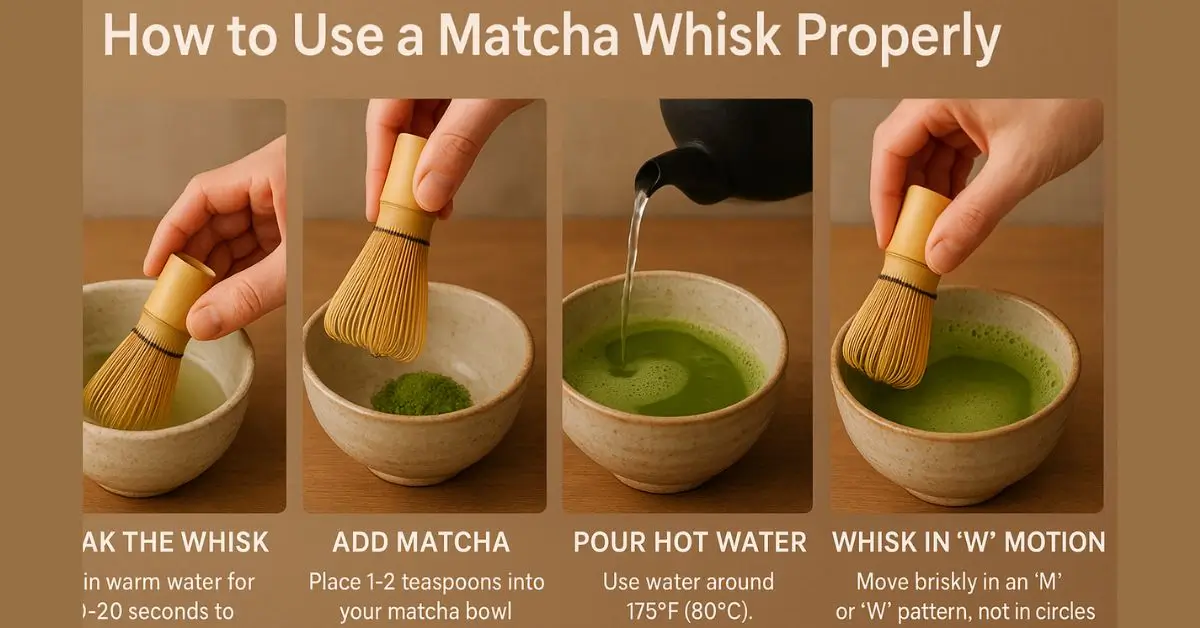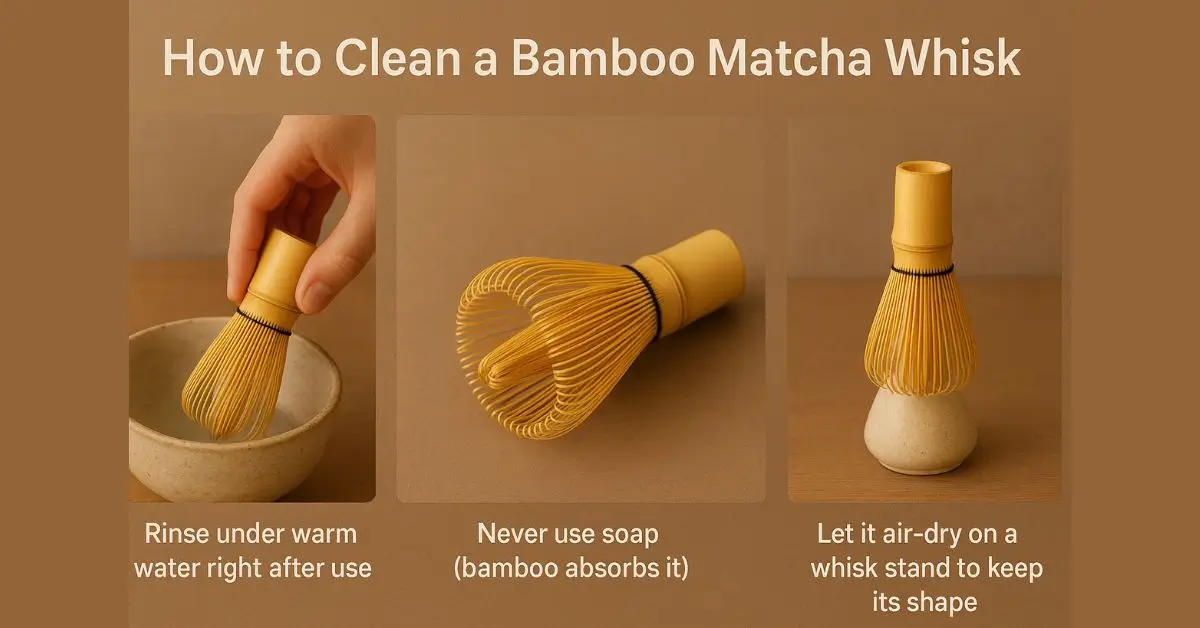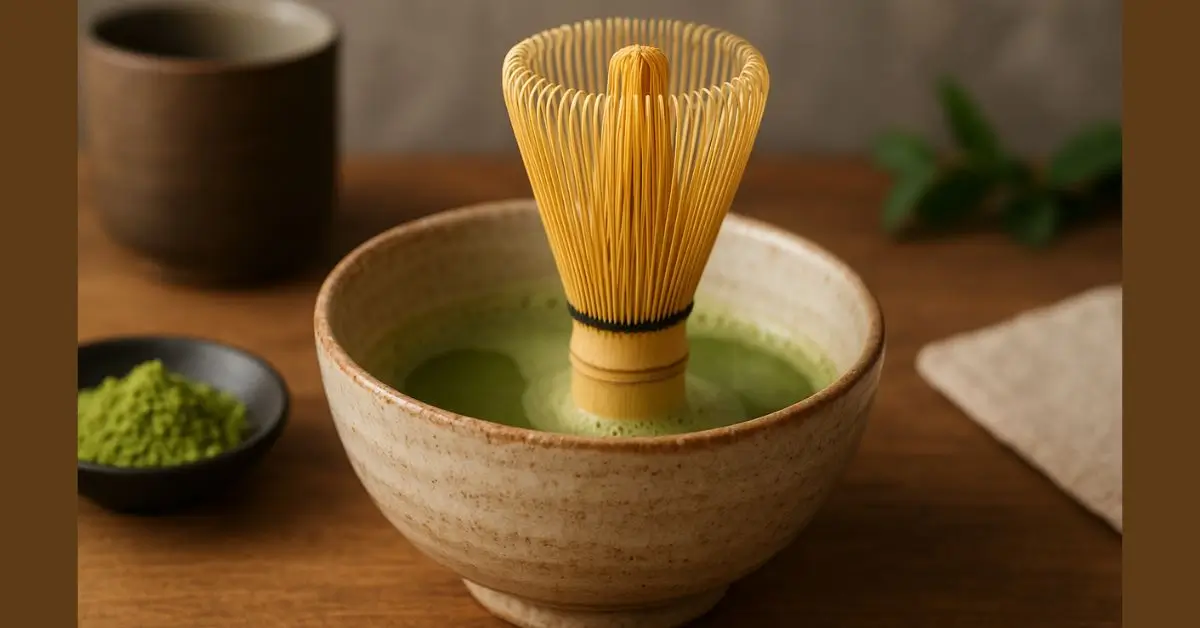If you’ve ever tried whisking matcha with a spoon only to end up with clumps floating on top, you’re not alone. A matcha whisk isn’t just another kitchen gadget — it’s the heart of Japanese tea preparation. For tea lovers, health-conscious drinkers, home baristas, and even food bloggers, the whisk is the tool that transforms a vibrant green powder into a creamy, calming drink.
Whether you’re running a café, creating content, or brewing matcha at home, knowing how to choose, use, and care for your whisk will elevate your experience. Let’s break it all down.
Quick Answer
A matcha whisk, or chasen, is a traditional bamboo tool used to blend powdered matcha into a smooth, frothy tea. It’s essential for authentic preparation, ensuring the right texture, flavor, and experience that electric frothers or spoons can’t replicate.
EXPLORE MORE
What Is a Matcha Whisk Used For?
A matcha whisk (chasen whisk) is made from a single piece of bamboo, carved into delicate tines. Its main purpose:
- Blend matcha powder with hot water
- Create a creamy foam layer
- Prevent clumps and uneven texture
- Unlock the full aroma of high-grade matcha
Unlike spoons or electric frothers, the whisk aerates the tea, giving you that smooth, café-style finish.
Types of Matcha Whisks: Which One Do You Need?
| Type of Whisk | Features | Best For |
|---|---|---|
| Basic Bamboo Whisk | 70–80 tines | Beginners & daily use |
| Handmade Bamboo Whisk | Crafted by artisans, finer tines | Authentic ceremonies & enthusiasts |
| Takayama Bamboo Whisk | From Takayama, Japan (famous region) | Collectors & professionals |
| Durable Bamboo Whisk | Thick tines, less delicate | Heavy or frequent use |
How to Use a Matcha Whisk Properly

- Soak the whisk: Dip in warm water for 10–20 seconds to soften the bamboo.
- Add matcha: Place 1–2 teaspoons into your matcha bowl (chawan).
- Pour hot water: Use water around 175°F (80°C).
- Whisk in “W” motion: Move briskly in an “M” or “W” pattern, not in circles.
- Look for foam: You’ll know it’s ready when you see a thin layer of micro-bubbles.
Pro tip: Use your wrist, not your arm — it saves energy and gives better control.
How to Clean a Bamboo Matcha Whisk

- Rinse under warm water right after use
- Never use soap (bamboo absorbs it)
- Let it air-dry on a whisk stand to keep its shape
This simple care routine can make your handmade bamboo whisk last months instead of weeks.
Do You Really Need a Whisk for Matcha?
Technically, no. You could use an electric frother or even a blender. But if you’re chasing the authentic Japanese tea whisk experience, nothing replaces the chasen. Frothers can add foam, but they don’t capture the ritual, texture, or cultural meaning.
Matcha Whisk vs Electric Frother
| Feature | Bamboo Whisk | Electric Frother |
|---|---|---|
| Texture | Smooth, silky, authentic | Frothy, but less traditional |
| Cultural Value | Part of tea ceremony | Modern alternative |
| Portability | Lightweight, no batteries | Needs power |
| Longevity | Months with care | Years |
For cafés or quick drinks, a frother works. For enthusiasts, the whisk wins every time.
History of the Japanese Tea Whisk (Chasen)
The chasen dates back to the 15th century in Japan, tied to Zen Buddhism and the tea ceremony. According to Smithsonianmag.com, monks used matcha whisking as both meditation and hospitality. Today, regions like Takayama in Nara remain the world’s leading producers of authentic, handcrafted whisks.
Buying Guide: Where to Buy an Authentic Matcha Whisk
When shopping, keep an eye out for:
- Origin: Made in Japan (e.g., Takayama bamboo whisk) is more authentic than mass-produced alternatives.
- Material: 100% natural bamboo.
- Sets: Many sellers offer a bamboo matcha whisk set with bowl for beginners.
- Price vs Quality: Beware of extremely cheap versions — they break easily.
Trusted places to buy: specialized tea shops, cultural goods stores, and reputable e-commerce sites like Amazon.com.
EXPERT ANSWERS
Do you need a whisk for matcha?
Not always, but without it, you’ll often get clumps and a flat drink. A whisk ensures smoothness and authenticity.
What is the best matcha whisk for beginners?
A basic 80-tine bamboo whisk is ideal — affordable, easy to use, and widely available.
Where can I buy a handmade Japanese chasen for sale?
Look for sellers from Nara, Japan, or certified cultural shops online. Authentic Japanese chasen brands usually highlight their origin.
Is there an affordable matcha whisk alternative?
Yes — handheld frothers or small blenders work. But if you want tradition, bamboo is the way.
Matcha whisk made in Japan vs China: What’s the difference?
Japanese whisks (e.g., Takayama bamboo whisk) are handcrafted with cultural precision, while many Chinese versions are machine-made, cheaper, and less durable.
FAQ’s
Q1: What is a matcha whisk used for?
It’s used to blend powdered matcha into hot water, creating a smooth, foamy drink.
Q2: How do you clean a bamboo matcha whisk?
Rinse with warm water and dry on a whisk stand — no soap needed.
Q3: What’s the difference between a matcha whisk and an electric frother?
A whisk is traditional and creates a finer foam, while a frother is convenient but less authentic.
Author Bio
Written by Daniel Carter — a content strategist and SEO writer specializing in wellness, culture, and food trends. With a background in English literature and years of experience crafting engaging blog content, Daniel helps brands connect with their audience through authentic, research-driven writing.












